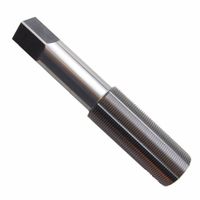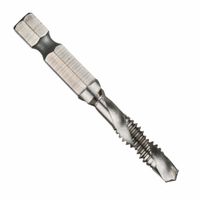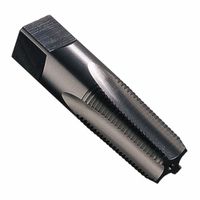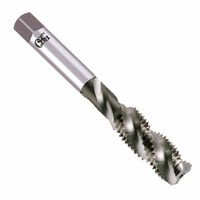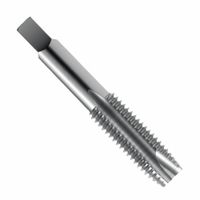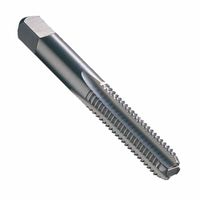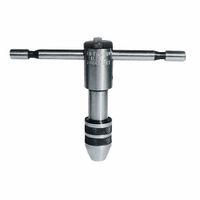Call +(254) 703 030 000 / 751 483 999 / 721 704 777
.....Read More
Frequently Asked Questions
What are the different types of taps used for internal threading?
1. **Hand Taps**: These are the most common taps and are typically used for general-purpose threading. They come in sets of three: taper tap, plug tap, and bottoming tap. The taper tap starts the thread, the plug tap continues it, and the bottoming tap finishes it to the bottom of a blind hole.
2. **Machine Taps**: Designed for use with machines, these taps are more robust and can handle higher speeds. They often have spiral points or spiral flutes to aid in chip removal and are used in production environments.
3. **Spiral Point Taps**: Also known as "gun taps," these have a spiral point that pushes chips ahead of the tap, making them ideal for through holes. They are efficient and reduce the risk of tap breakage.
4. **Spiral Flute Taps**: These taps have helical flutes that pull chips out of the hole, making them suitable for blind holes. They are particularly useful in materials that produce long, stringy chips.
5. **Bottoming Taps**: With only 1 to 1.5 threads chamfered, these taps are used to thread the bottom of a blind hole after a taper or plug tap has been used.
6. **Pipe Taps**: Used for threading pipe fittings, these taps create a tapered thread that ensures a tight seal. They are available in various standards like NPT (National Pipe Taper) and BSP (British Standard Pipe).
7. **Forming Taps**: Unlike cutting taps, forming taps displace material to create threads. They are used in ductile materials and produce stronger threads without chips.
8. **Interrupted Thread Taps**: These taps have gaps in the thread cutting edges, reducing friction and making them suitable for hard materials.
9. **Acme Taps**: Used for creating Acme threads, which are trapezoidal and used in power transmission applications.
10. **Taper Pipe Taps**: Specifically designed for creating tapered threads in pipes, ensuring a tight fit for fluid or gas transport.
How do chip-free thread-forming taps work?
Chip-free thread-forming taps, also known as roll taps or fluteless taps, work by displacing material rather than cutting it. These taps are designed with lobes or ridges that press against the walls of a pre-drilled hole, cold-forming the material into threads. The process involves the following steps:
1. **Pre-Drilling**: A hole slightly smaller than the desired thread size is drilled into the workpiece. The hole size is critical and must be precise to ensure proper thread formation.
2. **Material Displacement**: As the thread-forming tap is rotated into the hole, its lobes displace the material radially outward, creating the thread profile. The material flows into the spaces between the lobes, forming the crests and roots of the threads.
3. **Cold Forming**: The process is a type of cold forming, which strengthens the threads by work-hardening the material. This results in threads with higher tensile strength and better surface finish compared to cut threads.
4. **No Chips**: Since no material is removed, there are no chips produced, eliminating the need for chip removal and reducing the risk of tap breakage due to chip clogging.
5. **Lubrication**: Adequate lubrication is essential to reduce friction and prevent tool wear. It also aids in the smooth flow of material during the forming process.
6. **Applications**: Chip-free thread-forming taps are ideal for ductile materials like aluminum, copper, brass, and certain steels. They are commonly used in industries where thread strength and surface finish are critical, such as automotive and aerospace.
Overall, chip-free thread-forming taps offer advantages in terms of thread strength, tool life, and process efficiency, making them suitable for high-volume production environments.
What is the purpose of Acme taps?
Acme taps are specialized tools used for creating internal threads in materials, typically metal, that conform to the Acme thread standard. The Acme thread form is characterized by its trapezoidal shape, which provides greater strength and durability compared to other thread forms like the standard V-thread. This makes Acme threads particularly suitable for applications involving heavy loads and frequent movement, such as in lead screws, power screws, and other mechanical systems where precision and efficiency are critical.
The primary purpose of Acme taps is to cut these specific threads into a pre-drilled hole, allowing for the creation of a matching internal thread that can accommodate an Acme-threaded rod or screw. This is essential in manufacturing and repair processes where precise thread engagement is necessary to ensure the proper functioning of machinery and equipment.
Acme taps are designed to handle the unique geometry of Acme threads, which includes a wider thread profile and a larger root area. This design helps distribute stress more evenly across the threads, reducing the likelihood of wear and tear and enhancing the longevity of the threaded connection. Additionally, the trapezoidal shape of Acme threads allows for smoother and more efficient movement, which is crucial in applications like linear actuators and CNC machinery.
In summary, the purpose of Acme taps is to facilitate the creation of robust, durable, and precise internal threads that are essential for high-load and high-movement applications, ensuring the reliability and efficiency of mechanical systems.
How are extension, nut, and pulley taps different from standard taps?
Extension, nut, and pulley taps are specialized tools designed for specific threading applications, differing from standard taps in several ways:
1. **Extension Taps**: These taps have a longer shank than standard taps, allowing them to reach deeper into holes or areas that are otherwise inaccessible. They are used when the threading needs to be done in hard-to-reach places, such as deep cavities or recessed areas. The extended shank provides the necessary reach without compromising the tool's stability or performance.
2. **Nut Taps**: Nut taps are specifically designed for threading nuts. They have a shorter overall length and a more robust design to handle the repetitive and high-stress nature of threading nuts. The shorter length allows for better control and precision, while the robust construction ensures durability and efficiency in high-volume production environments.
3. **Pulley Taps**: These taps are used for threading holes in pulleys or similar components. They often feature a longer shank and a reduced diameter to fit through the pulley hub and reach the area where threading is required. The design ensures that the tap can navigate through narrow spaces and create threads without damaging the surrounding material.
In contrast, standard taps are general-purpose tools used for creating threads in a wide range of materials and applications. They come in various types, such as taper, plug, and bottoming taps, each suited for different stages of the threading process. Standard taps are versatile but may not be suitable for specialized tasks that require the unique features of extension, nut, or pulley taps.
What are garden hose taps used for?
Garden hose taps, also known as outdoor faucets or spigots, are primarily used to control the flow of water from a building's plumbing system to a garden hose. They serve several key functions:
1. **Watering Gardens and Lawns**: Garden hose taps are essential for maintaining gardens and lawns. They allow users to attach a hose for watering plants, flowers, and grass, ensuring that vegetation receives adequate moisture.
2. **Cleaning and Maintenance**: These taps are used for various cleaning tasks, such as washing cars, outdoor furniture, patios, and driveways. The water pressure from a hose connected to a tap can effectively remove dirt and debris.
3. **Filling Pools and Ponds**: Garden hose taps are used to fill swimming pools, ponds, and other water features. They provide a convenient way to add large volumes of water without the need for buckets or other containers.
4. **Irrigation Systems**: They can be connected to irrigation systems, such as sprinklers or drip irrigation setups, to automate the watering process. This helps in conserving water and ensuring even distribution across the garden.
5. **Outdoor Activities**: Garden hose taps are useful for outdoor activities, such as filling water balloons, setting up slip-and-slides, or providing water for pets and livestock.
6. **Emergency Use**: In emergencies, such as fires, a garden hose connected to a tap can be used to control small fires until professional help arrives.
7. **Construction and DIY Projects**: They provide water for mixing concrete, cleaning tools, or other construction-related tasks.
Overall, garden hose taps are versatile fixtures that facilitate various outdoor water-related activities, making them indispensable for homeowners and gardeners.
When should oversized taps be used?
Oversized taps should be used in situations where there is a need to accommodate specific conditions that standard taps cannot effectively address. These conditions include:
1. **Material Expansion**: When working with materials that expand significantly under heat or pressure, oversized taps allow for the necessary clearance to prevent binding or seizing of the fastener.
2. **Coating and Plating**: If a hole is to be coated or plated after tapping, oversized taps provide the extra space needed to account for the thickness of the coating, ensuring that the fastener can still be inserted and function properly.
3. **Thread Fit Adjustments**: In applications requiring a looser thread fit, such as when ease of assembly is prioritized or when components are frequently assembled and disassembled, oversized taps can create threads that allow for smoother engagement.
4. **Compensating for Wear**: In repair or maintenance scenarios where existing threads are worn or damaged, oversized taps can be used to re-tap the hole to a slightly larger size, allowing for the use of a larger fastener to restore functionality.
5. **Tolerance Stack-Up**: In assemblies where multiple components are stacked or aligned, oversized taps can help manage tolerance stack-up by providing additional clearance, reducing the risk of misalignment or binding.
6. **Soft or Brittle Materials**: When tapping soft or brittle materials, oversized taps can reduce the risk of cracking or breaking by minimizing the stress exerted during fastener insertion.
7. **High-Temperature Applications**: In environments with high temperatures, oversized taps can accommodate thermal expansion of both the fastener and the material, ensuring reliable performance.
In summary, oversized taps are essential in scenarios where additional clearance is needed to accommodate material properties, environmental conditions, or specific assembly requirements.
What are STI taps and how are they used?
STI taps, or Spiral Point Taps, are a type of cutting tool used to create threads in a pre-drilled hole. They are specifically designed for cutting threads in materials like metal, plastic, or wood. The "STI" stands for "Screw Thread Insert," which indicates that these taps are often used to prepare holes for the installation of threaded inserts, such as Helicoil inserts. These inserts are used to repair stripped threads or to provide a durable threaded hole in softer materials.
The design of STI taps includes a spiral point at the tip, which helps to push the chips forward and out of the hole as the tap cuts the threads. This feature makes them particularly effective for through-hole applications, where the chips can exit the opposite side of the material. The spiral point also reduces the risk of tap breakage by minimizing the amount of torque required during the tapping process.
STI taps are used in various industries, including automotive, aerospace, and manufacturing, where precise and durable threading is essential. They are typically used with a tap wrench or a machine tool, such as a drill press or CNC machine, to ensure accurate and consistent threading.
To use an STI tap, a hole is first drilled to the appropriate size for the specific tap being used. The tap is then aligned with the hole and rotated, either manually or with a machine, to cut the threads. Proper lubrication is often applied to reduce friction and heat, extending the life of the tap and improving the quality of the threads. Once the threads are cut, a threaded insert can be installed, providing a strong and reliable threaded connection.

